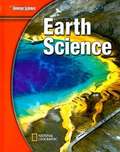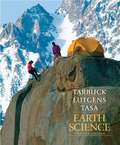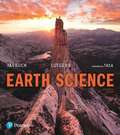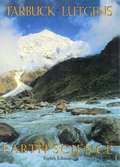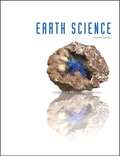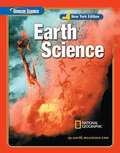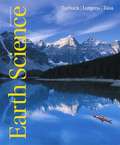- Table View
- List View
Earth Science
by Dinah Zike Ralph M. Feather Susan Leach Snyder McGraw-Hill-Glencoe StaffWith a broad array of innovative print and technology resources, Glencoe Earth Science helps teachers differentiate and accommodate all learners. The range of labs, content area reading, discussion strategies, note-taking tools, and activities provides students with multiple experiences of each Science Benchmark. They give teachers flexibility and the ability to monitor student progress through ongoing assessment.
Earth Science
by Edward J. Tarbuck Frederick K. LutgensIdeal for undergraduates with little or no science background, Earth Science provides a student-friendly overview of our physical environment that offers balanced, up-to-date coverage of geology, oceanography, astronomy, and meteorology. The authors’ texts have always been recognized for their readability, currency, dynamic art program, delivery of basic principles and instructor flexibility. The Fourteenth Edition incorporates a new active learning approach, a fully updated and mobile visual program, and MasteringGeology™–the most complete, easy-to-use, engaging tutorial and assessment tool available.
Earth Science
by James Sammons Mary Beth Abel Hughes Scott EddlemanEarth science includes the studies of geology, meteorology, astronomy, and oceanography. Each field involves scientists and engineers using math and technology to answer scientific questions and solve problems.
Earth Science
by PearsonEarth Science, 13th Edition, is designed for an 11th or 12th grade course in Earth science. It consists of seven units that emphasize broad and up-to-date coverage of basic topics and principles in geology, oceanography, meteorology, and astronomy. The book is intended to be a meaningful, nontechnical survey for students. In addition to being informative and up-to-date, Earth Science, 13th Edition strives to meet the need for a readable and user- friendly text and a highly usable "tool" for learning basic Earth science principles and concepts.
Earth Science
by Tarbuck Lutgensarth Science answers the need for a straightforward text that excites readers about the world around them. Perfect for individuals with little-to-no background in science, the text covers geology, oceanography, meteorology, and astronomy clearly and without technical jargon. Tarbuck, Lutgens, and Tasa are praised for their uncomplicated writing, dynamic media that help visualize physical processes, stunning art program that brings the “wow” factor, and valuable activities in Mastering Geology that provide activity-based learning to solidify readers’ understanding. The 15th Edition incorporates the latest data and applications from Earth Science, new data analysis activities, and an updated dynamic mobile media and Mastering Geology program.
Earth Science
by Utah Oer DoeWritten by a group of Utah teachers, this book focuses on the Utah State Science Standards for Earth science.
Earth Science (10th Edition)
by Edward J. Tarbuck Frederick K. Lutgens"Earth Science" offers a reader-friendly overview of our physical environment for the reader with little or no exposure to science. The emphasis is on readability, with clear explanations and examples, superb illustrations by the renowned Dennis Tasa, and an incredible collection of full color photographs and topographical maps. Topics covered in this highly readable and interesting book are geology, oceanography, astronomy, and meteorology. For readers needing a basic informational book about Earth Science.
Earth Science (California Edition)
by Edward J. Tarbuck Frederick K. LutgensThe California Earth Sciences strand is organized into ten general standard sets. The standard sets are Earth's Place in the Universe (Solar System), Earth's Place in the Universe (Stars, Galaxies, and the Universe), Dynamic Earth Processes, Energy in the Earth System (Solar Energy Enters, Heat Escapes), Energy in the Earth System (Ocean and Atmospheric Convection), Energy in the Earth System (Climate and Weather), Biogeochemical Cycles, Structure and Composition of the Atmosphere, California Geology, and Investigation and Experimentation. Each standard set is divided into a series of specific topic standards. Use this section as a preview for your Earth Science course, and as a review guide when you study for exams.
Earth Science (Eighth edition)
by Edward J. Tarbuck Frederick K. LutgensThe latest edition (fifth was 1988) of a broad and non-quantitative survey at the introductory level of topics in geology, oceanography, meteorology, and astronomy.
Earth Science (Illinois Edition)
by Houghton Mifflin HarcourtCollated for students to learn the Big Ideas and Key Concepts of Earth science and explains why the study of science in the various sections matters. An easy to read and interesting book to studying and learning about the earth, its composition, history, dynamic, reshaping of the crust, atmospheric forces, oceans and space.
Earth Science (New York Edition)
by Adele Carey Susan M. Killeen Elise RussoThis is an earth science textbook, New York edition.
Earth Science (Thirteenth Edition)
by Edward J. Tarbuck Frederick K. LutgensEarth Science, Thirteenth Edition, is a college-level text designed for an introductory course in Earth science. It consists of seven units that emphasize broad and up-to-date coverage of basic topics and principles in geology, oceanography, meteorology, and astronomy.
Earth Science 2011: Grades 9 and 10
by Edward J. Tarbuck Frederick K. LutgensHigh school earth sciences textbook
Earth Science 2019, Grades 6-8 (HMH Florida Science)
by Houghton Mifflin HarcourtHMH Florida Science Student Edition Grades 6-8 Earth 2019
Earth Science 2: What Makes the Weather Change? (IQWST)
by Joseph Krajcik Brian ReiserNIMAC-sourced textbook
Earth Science 3: How Is the Earth Changing?
by Joseph S. Krajcik Brian J. ReiserNIMAC-sourced textbook
Earth Science Florida 2006
by Mead A Allison Arthur T Degaetano Jay M PasachoffScience textbook for high school students
